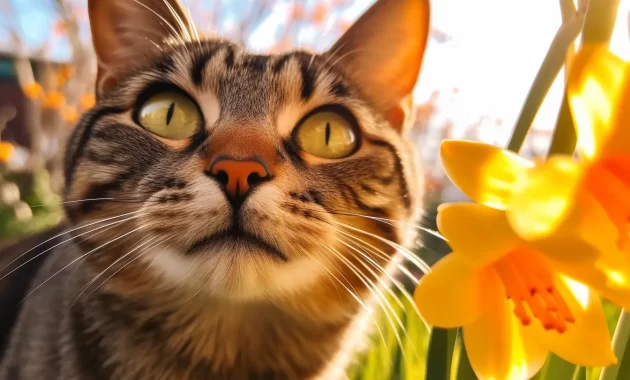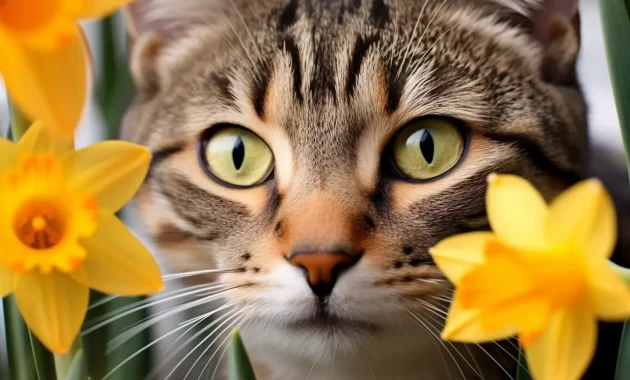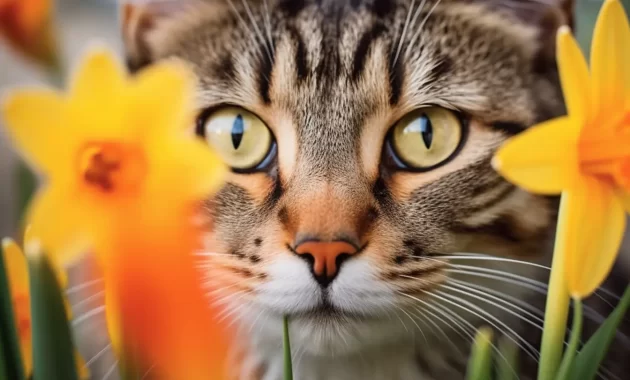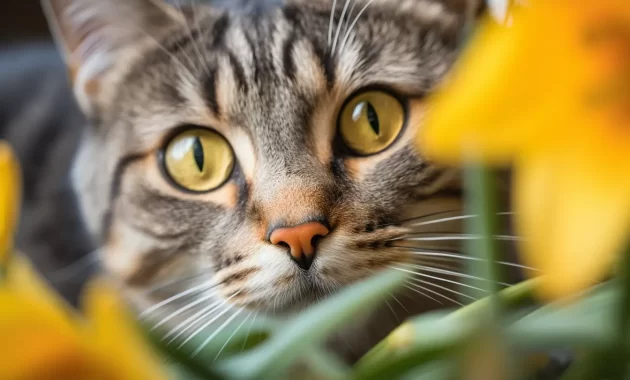
We all love our cats and want to ensure they’re safe and sound. But did you know that daffodils can be poisonous to cats?
Cat owners must understand these beautiful flowers’ risks to protect their furry friends.
In this article, we’ll dive into why cats should steer clear of daffodils and how you can keep them safe.
Let’s get started!
What Makes Daffodils Poisonous To Cats?

Do cats need to be kept away from daffodils? After all, they seem so harmless.
Unfortunately, many of us don’t know that these bright, yellow blooms can present potential risks to our feline friends.
Daffodils contain several toxic components which can cause severe effects in cats.
The most dangerous of these components are lycorine and calcium oxalate crystals.
Lycorine is a toxic alkaloid found in daffodils and other plants such as amaryllis, Easter lilies, and certain mushrooms.
Once ingested by cats, it can cause gastrointestinal upset and excessive salivation.
Calcium oxalate crystals are another major threat posed by daffodils for cats.
These tiny crystals are found in the leaves, stems and flowers of the plant, and if ingested, they can cause severe burning and irritation to the mouth and tongue, as well as difficulty swallowing or breathing due to throat swelling.
In extreme cases, vomiting may occur, leading to dehydration or even death if left untreated.
Given the potential risks associated with daffodils for cats, pet owners must ensure their furry friends always stay away from these plants.
SEE ALSO
5 Reasons Grey Savannah Cats Are Perfect For Apartment Living
Asian Short Hair Cats: The Gentle Giants
Symptoms Of Daffodil Poisoning In Cats

Cats are curious creatures; unfortunately, they can sometimes get into things they shouldn’t.
Daffodils are a common flower that can cause severe toxicity in cats if ingested.
To ensure their safety, it is essential to be aware of the signs and symptoms of daffodil toxicity in cats.
When cats ingest daffodils, vomiting and drooling may occur within minutes of ingestion.
Gastrointestinal irritation can also occur, leading to abdominal pain, diarrhea, and anorexia.
Clinical signs may vary from mild to severe depending on the amount of ingested.
Other signs of daffodil toxicity include cardiac arrhythmias, seizures, tremors or muscle twitching, and respiratory depression or failure.
If you suspect your cat has ingested daffodils, it is essential to seek medical attention immediately, as these symptoms can be fatal if left untreated.
Pet owners need to be aware of the dangers posed by daffodils so that steps can be taken to ensure their cat’s safety.
Remove or replace with a non-toxic alternative should be considered if you notice your cat eating flowers or plants around your home or garden.
Additionally, keeping plants out of reach of cats is an essential preventative measure that must be taken to protect them from potential harm.
How To Prevent Cats From Eating Daffodils

Cats and daffodils are a tricky combination.
On the one hand, the bright yellow flowers of the daffodil can bring cheerful beauty to any indoor space; on the other, cats may be tempted to nibble on their petals.
But before you send your furry friend away for fear of poisoning them, it’s essential to understand the potential risks.
The good news is that daffodils are generally considered non-toxic to cats and dogs.
However, it’s essential to keep an eye on your pet if they come in contact with these flowers; if a cat has ingested any part of a daffodil, there is still the potential for a gastrointestinal upset or mild poisoning.
Keeping cats away from your indoor plants is essential to avoid this risk.
There are several ways to keep cats from eating your daffodils or other houseplants.
Consider placing plants in an inaccessible area to cats, such as high shelves or hanging baskets that are too high for them to reach.
You can also try sprinkling cayenne pepper around the base of the plant – while it won’t harm your pet, they will likely find it unpleasant and stay away!
Treatment For Daffodil Poisoning In Cats
If your beloved feline has ingested a daffodil, it is essential to act quickly.
As cats are susceptible to these flowers’ toxins, the pet must be monitored closely for poisoning symptoms.
A vet consultation is necessary for proper treatment if vomiting or lethargy is observed.
Treatment for daffodil poisoning in cats typically starts with administering detoxifying agents to reduce the risk of further damage caused by the toxins. Such agents can help flush out any remaining toxins from the cat’s system and limit their absorption into the body.
The vet may also prescribe additional medications such as anti-emetics or anticonvulsants to assist in relieving any symptoms of toxicity.
All possible measures must be taken to ensure your cat fully recovers from their exposure to the daffodil toxin.
Regular monitoring by a qualified veterinarian is necessary during this process.
With the proper care and attention, your furry companion will soon return to their playful self again!
Cat Profile : long hair Russian blue cat
https://toppetshop.co.uk/russian-blue-longhair-cats/
Alternatives To Daffodils For Cat Owners
As we have seen, the effects can be severe if a cat ingests daffodil bulbs or flowers.
However, there are ways to prevent such cases and some alternatives that cat owners can use in their gardens instead of daffodils.
| Flower | Pet Safe? | Toxic Parts |
|---|---|---|
| Marigold | Yes | None |
| Zinnia | Yes | None |
| Daisy | Yes | Leaves |
| Snapdragon | No | All parts |
| Daffodil | No | All parts |
As veterinarians, we are responsible for ensuring that pet owners are aware of the potential dangers certain plants may pose to their furry friends.
While many flowers are safe for cats, such as marigolds, zinnias, and daisies (except the leaves on daisies), some should be avoided at all costs, such as snapdragons and daffodils.
To help pet owners make informed decisions when choosing plants for their cat-safe garden, we’ve included a table above summarizing which flowers are safe and which should be avoided.
Cats should never be allowed to eat any part of a flower.
Even with pet-safe varieties such as marigolds, zinnias, and daisies, it is essential to watch your feline friend, as cats tend to explore new things with their mouths first!
If you’re ever unsure about the safety of a plant for your pet, contact your local veterinarian for advice.
Frequently Asked Questions
Can Cats Be Exposed To Daffodils Through Contact With Their Skin?
Regarding feline allergies, cats can be exposed to daffodils through contact with their skin.
This means that if a cat touches the daffodil or rubs against it, there is potential for an allergic reaction.
However, this does not mean the daffodil is poisonous to cats if ingested. Ingesting daffodils can result in toxic ingestion, so keeping cats away is essential.
If you think your cat may have come into contact with a daffodil, pay attention to any signs of an allergic reaction and seek medical help if necessary.
Are There Any Plants Similar To Daffodils That Are Safe For Cats?
Numerous plants have similar characteristics to daffodils yet may not have the same toxic effects.
As such, cats can safely explore alternative plants, like azaleas, impatiens and petunias, without fear of health implications.
However, it is essential to note that although these plants are generally safe for cats, contact with any plant should be monitored carefully to ensure no skin reactions occur.
By doing so, cats can enjoy the beauty of nature without worrying about potential risks.
How Long Does It Take For Symptoms Of Daffodil Poisoning To Show Up In Cats?
Cats who ingest daffodils may experience poisoning symptoms within a few hours to two days.
Symptoms include vomiting, diarrhea, drooling, seizures, and abdominal pain.
Treatment options vary depending on the severity of the poisoning and can range from watching for symptoms at home to intensive care in the hospital.
If you suspect your cat has ingested daffodil or any other poisonous plant, it’s essential to seek medical attention immediately.
What Is The Best Way To Safely Remove Daffodils From A Cat’s Environment?
When it comes to pet-proofing your home, it’s essential to consider any potential toxic effects of the plants you have.
Daffodils are toxic to cats, so if you suspect your cat has been exposed to them, the best way to safely remove them from the environment is to contact a professional.
They will be able to advise on how best to remove the daffodils and provide advice on how to make sure that your pet is not at risk of further exposure.
Is There Any Way To Treat Daffodil Poisoning In Cats At Home?
It can be frightening when you realize your beloved cat has been exposed to potentially dangerous daffodils.
The best way to prevent access and avoid potential poisoning is by keeping cats away from the plants.
However, seeking immediate veterinary treatment is essential if your pet ingests them.
At-home remedies may not be sufficient to treat cat daffodil poisoning, and attempting to do so could cause further harm.
Conclusion
Cats should never be exposed to daffodils, as they are highly toxic and can lead to severe illness or even death.
It is important for cat owners to remove these plants from their cats’ environment and be aware of similar plants that may look harmless but can also be harmful.
Even if symptoms of daffodil poisoning don’t appear immediately, it’s crucial to seek medical attention for your cat as soon as possible.
With the help of a qualified veterinarian, your cat can receive the treatment needed to recover fully.




